Mushroom varieties of mushrooms thrive in various environments. A significant number of these fungi favor wood as their primary nutrient source, commonly flourishing on tree stumps. Not only are many of these mushrooms edible, but they also offer health benefits. Therefore, it’s worthwhile not to overlook them during forest walks, hikes, or leisurely strolls in parks.
Let’s delve into the topic of mushrooms growing on tree stumps, from their diverse species to cultivation techniques and medicinal properties.
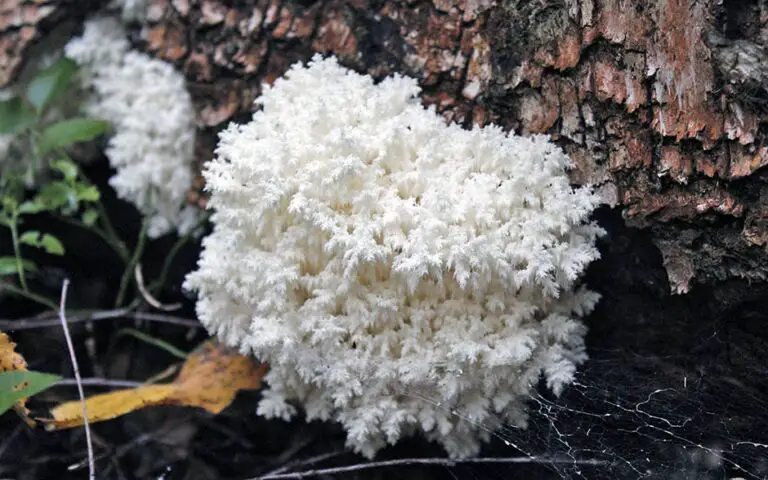
14 Mushrooms Growing on Tree Stump
Table of Contents
What mushrooms and why grow on stumps?
Various types of mushrooms, including edible, inedible, and poisonous ones, can be found growing on both stumps and trees. They utilize the wood as a nutrient-rich substrate for their growth, regardless of whether the tree is dry, decaying, or actively growing. Interestingly, different species within the same tree family can yield distinct fruits.
Some mushrooms play the role of nature’s caretakers. They thrive on stumps and dry wood, allowing their mycelium to penetrate deep within the wood’s fibers. Feeding on the remnants of decaying wood, they contribute to its gradual breakdown. This slow yet steady process ultimately rejuvenates the soil, making way for new vegetation to flourish.
Read out Edible Mushrooms that Grow on Trees.
Among the edible varieties of mushrooms that can be found on trees and stumps, there are several delicious and nutritious options:
- Honey mushrooms: Typically found at the base of trees.
- Oyster mushrooms: They prefer tree trunks or stumps.
- Lion’s Mane mushroom (also known as Hericium): Recognizable by its unique appearance.
- Chicken of the Woods: Often found on living trees, resembling animal liver in appearance.
- Hedgehog mushroom: Surprisingly tasty, despite its coral-like appearance.
- Velvet Shank: Fond of deciduous trees and valued for its high protein content.
- Chicken-of-the-Woods: Grows on deciduous trees and stumps, adaptable to various forest types.
However, alongside these beneficial varieties, there are also dangerous mushrooms that should be avoided:
- Ischnoderma resinous: Inedible and potentially harmful.
- Ganoderma resinaceum: Rare in Russia but widespread elsewhere.
- Bitter Polypore: Known for secreting liquid droplets.
- Trametes versicolor: An annual fungus that often grows in clusters on dead wood.
When foraging for mushrooms, it’s essential to be able to distinguish between these types to ensure safety and enjoyment.
Edible Mushrooms Growing on Tree Stump
Edible mushrooms growing on stumps are generally safe for collection and culinary use. While personal taste preferences may vary, and not all varieties are equally nutritious, they pose no harm to human health. Therefore, foragers can confidently gather them for cooking without concerns about potential health risks.
Honey mushrooms
Honey mushrooms encompass a variety of species across different families, each with its own distinctive traits:
- Winter Honey Agaric: Typically found on poplar or willow trunks, sporting a brown cap with a dark center spot. Its fuzzy stem reaches heights of up to 7 cm, often growing in clusters during early spring.
- Summer Honey Agaric: Thrives in moderate climates, favoring deciduous trees. Its broad cap, ranging from yellow to brown, fruits from late spring through autumn.
- Autumn Honey Agaric: Commonly sighted on the stumps of deciduous trees, characterized by a greenish or brown cap measuring approximately 17 cm in diameter. Esteemed for its culinary qualities, this species holds particular value.
A word of caution: Each mushroom type has its own inedible counterparts. If a mushroom exhibits a ring on its stem, it is likely false and should be avoided.
oyster mushrooms
These fruits are typically found on dried wood or stumps. Mushrooms may take the shape of ears or petals, and oyster mushrooms come in various forms such as horn-shaped, pulmonary, or orange. They tend to thrive on deciduous trees, exhibiting colors ranging from whitish to grayish.
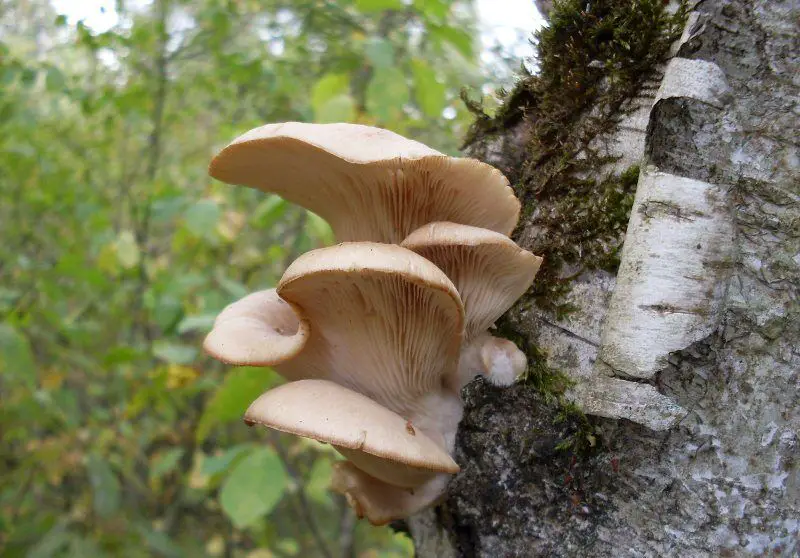
Their fruiting season spans from late September to November, and they are commonly found in areas abundant with oak and mountain ash trees. Below are pictures and names of Mushrooms that Grow in Grass on Meadow, Field, Yard, Lawn.
Polyporus umbellatus
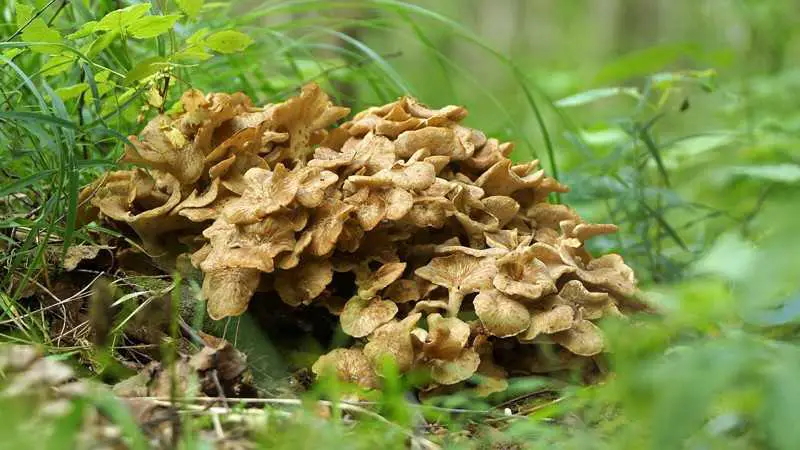
The mushroom boasts numerous caps and a branching body, resembling a “bush” with a diameter of up to 80 cm. Its color ranges from yellowish to gray or yellowish-brown. Weighing up to 10 kg, it stands as one of the largest fruiting bodies found on stumps and trees. The prime time for harvesting falls between August and September.
beefsteak mushroom
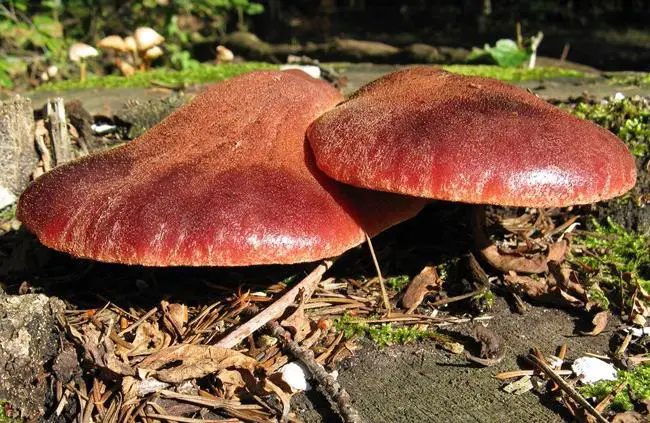
The beefsteak mushroom, a delectable delicacy, undergoes various culinary treatments such as drying, boiling, frying, and marinating. Its distinctive appearance sets it apart from other fungi, resembling somewhat a tinder fungus while also bearing a likeness to animal liver or tongue, hence its colloquial name “mother-in-law’s tongue”. Sporting a reddish-brown hue, this mushroom exclusively thrives on living trees, with a preference for chestnut and oak hosts.
Coral tooth fungus
This fruit boasts a peculiar appearance with a prominently developed aerial structure. Its name stems from its striking resemblance to a coral sea bush, while its coloration ranges from creamy tones with hints of yellow.
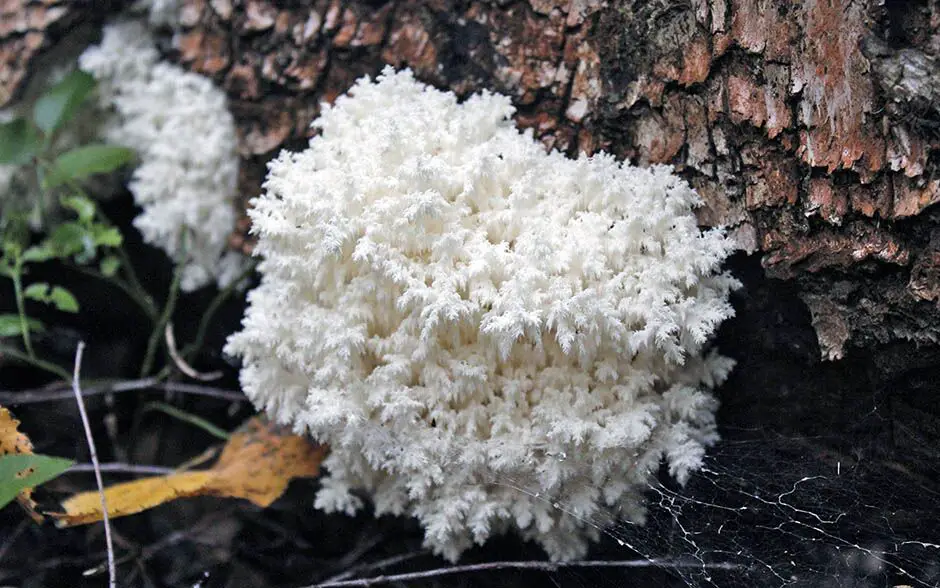
This fungus thrives in habitats such as fallen trees and aged hollows of elm, oak, beech, and linden trees.
Impressively versatile, this fruit finds utility beyond the culinary realm, also serving as a key ingredient in various medicinal formulations.
Detailed guide on Mushrooms that grow on Poplar trees.
tiger sawgill
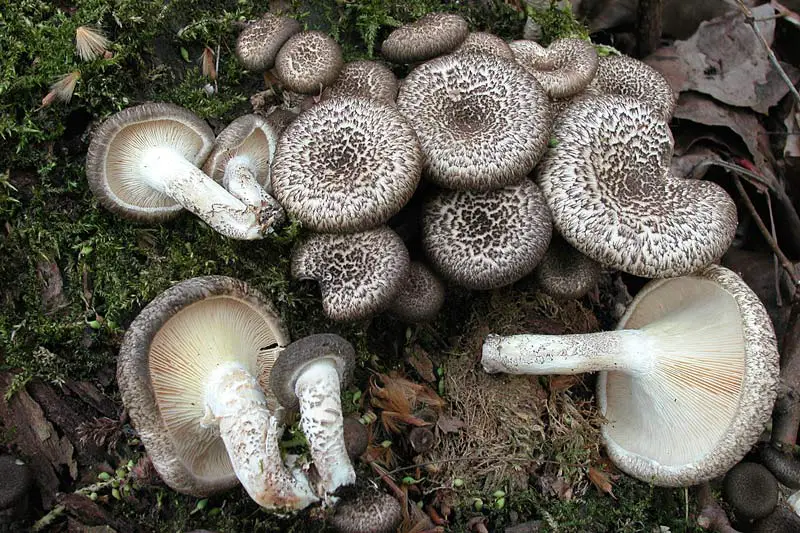
The tinder fungus features an oval or semicircular cap, typically yellow with a reddish tint and covered in small scales, reaching sizes between 2 to 8 cm in diameter.
Its white stem, approximately 10 mm in length, is positioned laterally rather than centrally on the fungus. Lacking a distinctive aroma or flavor, it exclusively thrives on deciduous trees. Its growth season spans from April to August.
Polyporus alveolaris
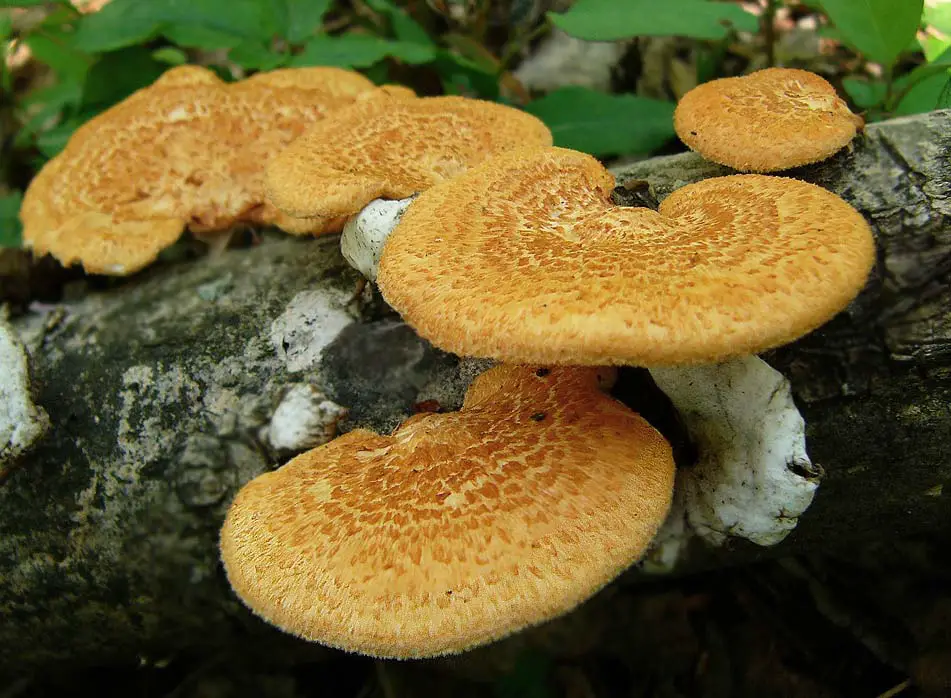
The tinder fungus displays an oval or semicircular cap, typically yellow with a reddish hue, adorned with small scales, and reaching diameters of 2-8 cm.
Its stem is white, around 10 mm in length, positioned laterally rather than centrally on the fungus. Lacking any distinct scent or flavor, it exclusively thrives on deciduous trees, with its growth season spanning from April to August.
inedible Mushrooms Growing on Tree Stump
Amidst the array of mushrooms growing on tree stumps, there exist inedible varieties. These demand discernment, requiring recognition either immediately or upon thorough inspection.
Ischnoderma resinous
Sizeable, with a cap reaching approximately 20 cm and a thickness of 3-4 cm, it boasts a smooth surface adorned with black patches. Its tubular hymenophore presents creamy hues in youth, maturing to darker, brown tones. Ischnoderma resinous thrives on fallen trees, stumps, and decaying wood from early August through late October.
Ganoderma is lively
Emerging from tree bark, it lacks a distinct stem, its cap resembling a flat comb. Affixed to trees or occasionally soil, its dark-colored flesh is tender and yielding to the touch.
Oligoporus astringent
Widespread and often white, this mushroom typically exhibits sharp-edged caps, occasionally blunt. It may grow solitarily or in clusters.
Fleshy and succulent, its pulp bears a profoundly bitter taste. Cap thickness ranges from 3 to 4 cm, while the fruiting body surface remains largely smooth, occasionally exhibiting slight pubescence.
Enduring and adaptable, Oligoporus astringent thrives in diverse conditions, yet its flesh maintains its bitter flavor.
Trametes coated
This non-edible fruit exhibits a gray exterior and tough flesh. It primarily thrives in pine forests, yet can also be spotted on birch trees. Typically, it favors stumps as its preferred nutrient-rich substrate. Despite heat treatment, its bitter taste remains unaltered.
See Mushrooms that grow on birch Trees.
Medicinal Mushrooms Growing on Tree Stump
Many mushrooms have long been successfully used in folk medicine and official pharmacology. Based on them, medicines are made infusions, alcohol extracts, tablets, capsules, powders, etc.
larch sponge
The fruiting body of Agaricus resembles a hoof in shape, but can also be oblong-cylindrical. The weight is about 10 kg. They are white, grayish white or pale yellow. They often grow on larch.
Tree fungus has the following medicinal effects:
- laxative;
- hemostatic;
- sedative;
- hypnotic.
Birch chaga
Despite its name, Chaga grows not only on birch. It can also be found on linden or alder. Due to its dark color and unusual shape, this fungus is extremely difficult to confuse with other types of tinder fungus.
Chaga normalizes sleep and digestion, increases appetite, and has an antitumor effect. In folk medicine, remedies with this fungus are taken for uterine fibroids and endometriosis.
Mushroom raisins
This fruit has an ovoid or kidney-shaped cap. Its skin is smooth, shiny, as if varnished. For this reason, the fruit received another name varnished tinder fungus.
The color is different: red, purple, brown or even black. The flesh of this fungus is ocher, has neither a specific taste nor a pronounced smell.
Reishi mushroom grows, usually on the wood of dead trees and stumps.
Want to know about Mushrooms That Grow in Bunches.
Features of growing mushrooms on stumps in garden
All varieties of edible “hemp” mushrooms are suitable for home cultivation. Instead of stumps, sections of deciduous trees can serve as viable substrates. However, fresh stumps from recently felled dry trees are also suitable for planting these mushrooms.
Note! The cultivation of oyster mushrooms, which love poplar, maple and birch, is very popular. At the same time, it is not recommended to use conifers due to the high content of resins that can destroy the mycelium.
To cultivate fruiting bodies on dry wood, preparation is essential. Begin by soaking the wood in clean water using a container. Once prepared, proceed to transfer the mycelium of the chosen fungus. This involves creating recesses in the wood, arranged akin to a chessboard pattern. Each recess should be no more than 6 cm deep and 1 cm wide.
The mycelium is carefully inserted into these holes. Following this, the openings are sealed with moss or tape. All logs containing the mycelium should then be stored in a cool environment such as a basement or cellar. Stumps, on the other hand, should be arranged in a pyramid shape and covered with burlap.
Home mushroom cultivation extends beyond just using stumps. Once the mycelium has sprouted, the stumps should be transplanted into the ground. To ensure a successful continuation of the process, the makeshift soil should be periodically watered. With proper care, a bountiful harvest of homemade mushrooms can be expected before long.
Conclusion
Mushrooms growing on tree stumps offer a fascinating glimpse into the intricate workings of nature. From culinary delights to medicinal marvels, these fungi enrich our lives in myriad ways. Whether foraging in the wild or cultivating at home, let’s embrace the bounty of the fungi kingdom with reverence and curiosity.
